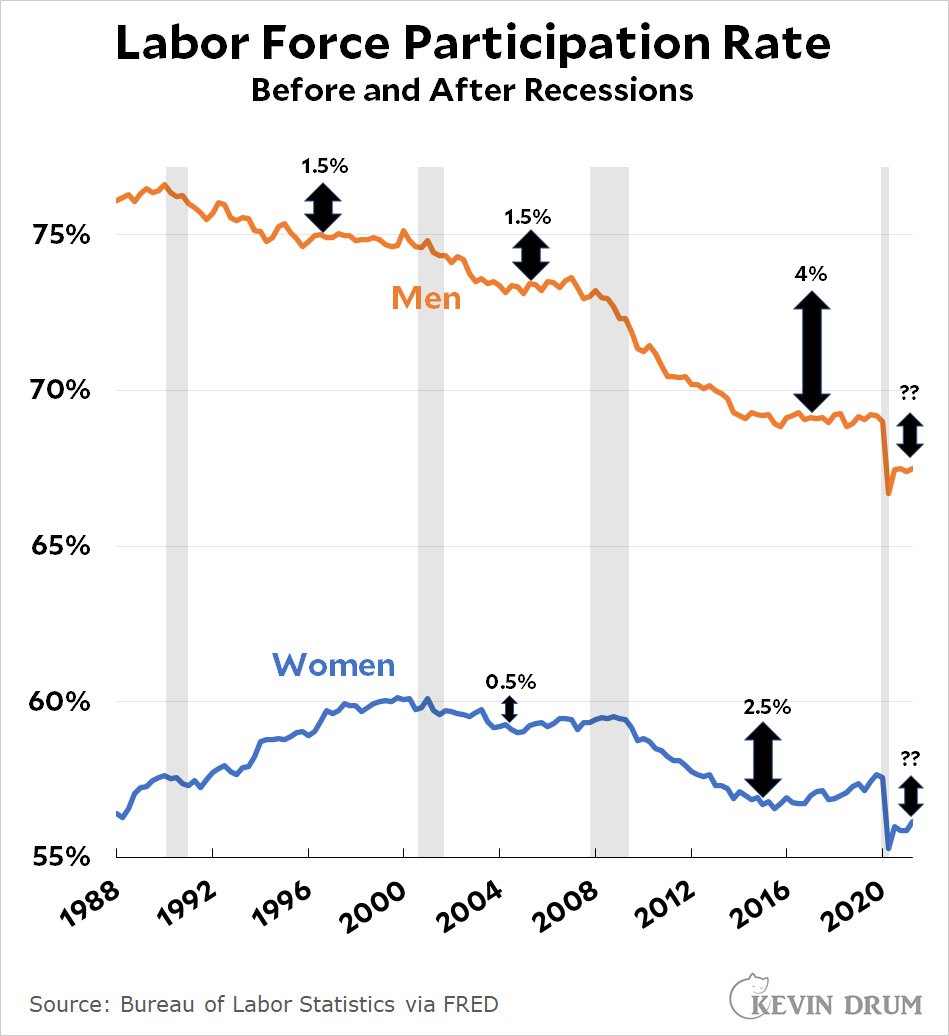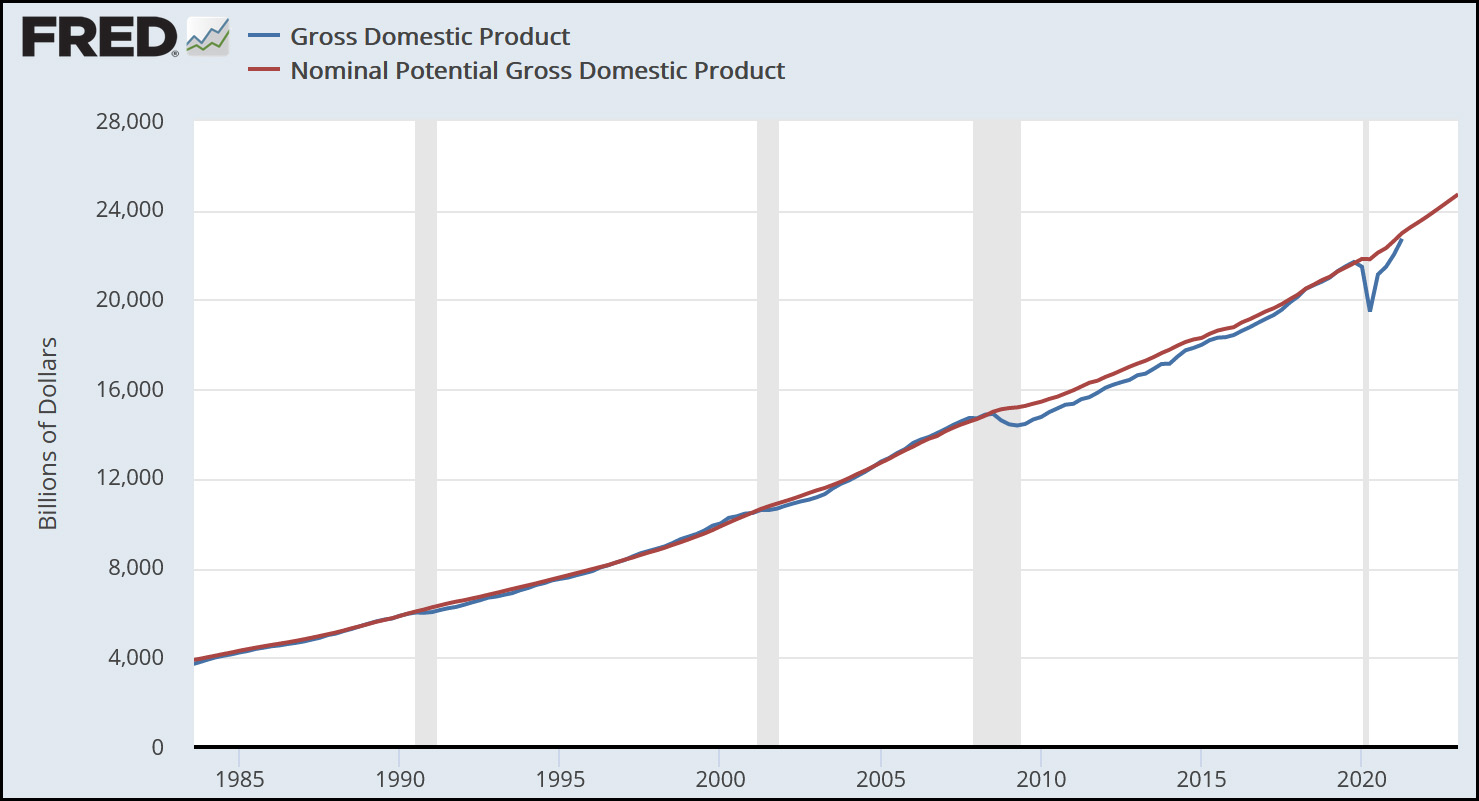Behold this chart showing the Labor Force Participation Rate over the past few decades:

The LFPR is exactly what it sounds like: it's the percentage of the adult population that's either employed or looking for employment. Let's take a look at men first.
After the 1990 recession, the LFPR for men dropped by about 1.5 percentage points and then flattened out. After the 2000 recession, ditto. After the 2008 recession, the loss was about 4 percentage points. In other words, after every recession the LFPR ends up at a permanently lower level.
This has now happened often enough that we should expect something similar to happen this time around: the LFPR will end up dropping about one point or so and then flattening out at around 68%. This is only about 0.5 points above where we are right now, which equates to less than one million people.
Among women we see a similar thing, though it's smaller and didn't start until the 2000 recession. At a rough guess, we should expect the LFPR for women to end up about one point from where it is now, which equates to two million people.
Altogether, then, this makes it look like we'll add about 3 million workers before the LFPR flattens out again. Looking at the unemployment rate provides a similar number. This is a lot less than the 10 million people who are supposedly looking for jobs.
There are no sure things here, but numbers like these are why I continue to think there are fewer people looking for jobs than we think. I'd put it at 3-5 million, at which point the unemployment rate is 3-4% and the economy is operating at 100% of its potential:

Can we boost the LFPR? Yes indeed. We just have to pay people more to lure them into the job market. Can we raise potential GDP? Also yes, in theory, but that's a slower, more complicated process and no one is entirely sure if we can do it—or what risks it involves. It's currently a matter of some controversy.
I would love to be wrong about this, but I'm not sure I see any reason to think that the US economy is on track to suddenly explode above its potential. The fast and massive stimulus spending did its job, but its job was to speed up our recovery, not to raise the economy to a permanently higher level.¹ The good news is that it did this marvelously. The bad news is that having done it, there's not much more we can expect it to do.
¹Its other job, of course, was to help people who were hard hit by the recession. That's not germane to a macroeconomic discussion, but it's certainly why massive stimulus is worthwhile regardless of its broader effects.

Kevin while your statement may, in fact, be accurate that finding would be suboptimal politically. To my surprise unemployment (believe its the U# measure) went down to 3.5% during the Trump term (pre Covid). I believe we are currently at 5.4%.
One hopes we could achieve much lower unemployment ....
5.2%, but that will drop over the next several months. The said, the decline in nlfr is as much demo than anything else. Do you really think the economy was on par with 2000's peak in 2019???? My guess no. Structural changes since the 90's and really the 70's tell me 2.5% or a 1.5 premium to 2000 is the max fall rate.
Capitalism simply doesn't have growth potential it did in th past. No new technology to drive debt expansion into capital expansion. 1.5% growth is all about the system can do before debt excess creates bubbles. The 2010's was subprime banking. We all know about prime lending boom of the 00's. The elite must admit or change.
You're joking, right? Computer tech continues to advance at blinding speed. Decarbonization is going to call for enormous investment for decades, both to deploy existing technology on a huge scale and to develop new tech which will also need to be deployed on a huge scale, all of which can be expected to produce an economic boom, for decades. Biotechnology is just barely getting started. There are fortunes to be spent, and fortunes to be made. I expect the most successful entrepreneurs of the decarbonization effort will accumulate wealth on a scale that will make Bezos or Gates look poor.
In words that Robert A. Heinlein had one of his characters (Delos Harriman, for the curious) say, about 70 years ago, "It's raining soup, grab yourself a bucket".
Hence the discussion of the shortfall in the number of workers and the need for immigration.
That said, what can be done to lure people a jobs back to smaller cities and some rural areas? Farming just doesn't need then number of people it used to. Even a number of migrant worker jobs has dropped as we now have migrant harvesters.
I would think the reconciliation bill can help, and was wondering why Manchin was opposing some provisions, e.g. free community college. I'm guessing his constituents fear that if their kids go to college, any college, they'll leave town. Broad band access, green power generation and green jobs can really help rural areas, but that might turn the base voters blue so local governments might look askance at that.
There isn't a need for immigration, but labor reallocation.
“We will have to staff up,” Mr. Irvine said. “And no, there are not enough skilled workers to fill these jobs.”
Mr. Biden has hailed the $1 trillion infrastructure bill as a way to create millions of jobs, but as the country faces a dire shortage of skilled workers, researchers and economists say companies may find it difficult to fill all of those positions.
https://www.nytimes.com/2021/09/09/us/politics/biden-infrastructure-plan.html?action=click&module=Well&pgtype=Homepage§ion=Business
This rings true to me, but I think we pass this funding then worry about the staffing issues later. No one is going to expand capacity or build a training program unless they have some reasonable prospect of it working out over the long run.
It doesn’t matter if the projects take longer. The work needs to be done and we have to figure out how to do it.
One of the neat things about planning in the medium-long term, like 10 years, is that if shortages develop there's time to remedy them. It generally takes three or four years to train a journeyman tradesman or a technician, longer to train new engineers and scientists. Free community college might not be a bad start on getting that training done.
U-6 headed downward; 6.8% appears to be the ballpark figure of full employment: https://fred.stlouisfed.org/graph/?g=GFWs
However, there's Atlanta Fed: https://www.stlouisfed.org/on-the-economy/2021/September/staff-pick-older-workers-accounted-all-net-employment-growth
I'm old enough to remember when we welcomed the prospect of having to spend a smaller portion of our lives working as a great benefit of technological change, not a deplorable affront to the great god GDP.
Agreed, many times over.
That all changed when Milton Friedman made putting profits over everything else respectable in the world of academia. The Harvard Business School then taught his “greed is the greatest good” ideology to its students.
https://www.newsweek.com/2017/04/14/harvard-business-school-financial-crisis-economics-578378.html?utm_source=internal&utm_campaign=most_read&utm_medium=most_read5
Reagan then sold that toxic belief to the general public with his “aw shucks” nice guy schtick which the media fell hard for.
I agree with many of the posts on this subject
But lets be very careful here we are dealing with a pandemic induced recession - not a failing of the overall economy
In 1917-1918 the pandemic ended quickly and we in the United States went into the roaring 20s and we all know how that ended. But that happened when the U.S. was still a small country with limited population - we are over 3 times more populated now. WE had no Federal Reserve, No social security, no unemployment insurance, No bureau of labor statistics etc.
Older workers COULD fill the void on many jobs in todays economy but they have to have 2 "protections" in place
FIRST and foremost = they have to be protected from COVID. They don't want to catch it from adults or children and
SECOND - they need to be able to make this extra cash without paying the penalty for making too much while collection Social Security.
If you can make these two things happen you may get some folks off the sideline. But you get some "karen" yelling at them as they wait tables and all bets are off.
But it is VERY bad out there for employers. My daughter runs a district for a major fast food chain in MASS. She, due to shortages of labor has 28% minors employed in her stores. They need to be home by 9 or 10 pm but many cannot drive after dark so managers (and she) had to drive them home, pick them up or both. They were using Uber and Lyft but THEY cannot find help. YOu know what they did? They hired a full time driver - provided liability insurance for the vehicle, paid this person $15.75/hr and then put in the $0.51/mile addition to it. The driver is happy cause it's work people, NOT drunks coming home from a bar. The parents of these kids LOVE it they provide NO transportation to and from work. The kids love it cause they get to be on their cell phones until they get home. The unit managers love it because they no longer have to scrounge around for rides. My daughter's Uber/Lift expenses were outrageous and now that is gone (It's now considered a corporate expense).
I have never seen anything like this
COVID ended working life for many people. The ONLY way to get older workers back in is to relax the rules for Social security earnings AND keep them safe. I don't think anyone can do both
It's well known that the population is aging and the proportion of retired people is consequently rising. How does the LFPR compare to the percentage of the population of prime working age (roughly 25-60)?
Harvard Business School did a report on "hidden workers" but what it amounts to is hidden unemployment: https://www.hbs.edu/managing-the-future-of-work/Documents/research/hiddenworkers09032021.pdf
Each successive recession in the last 40 years has progressively removed workers from the workforce, but the pace of this has accelerated with the widespread adoption of Applicant Tracking Systems that automatically weed out anyone for discontinuous employment. According to the people who write the code, it's better if you're an average employee who maintains employment than someone who is highly skilled but unmotivated to stay in the workforce continuously.
People who have been out of the workforce for short periods of time are not automatically bounced from consideration-- that's a gross overstatement and most of us know people who have found new jobs in that situation, or maybe we were those people. Even longer periods can be excused if they're for childbirth leave or education.